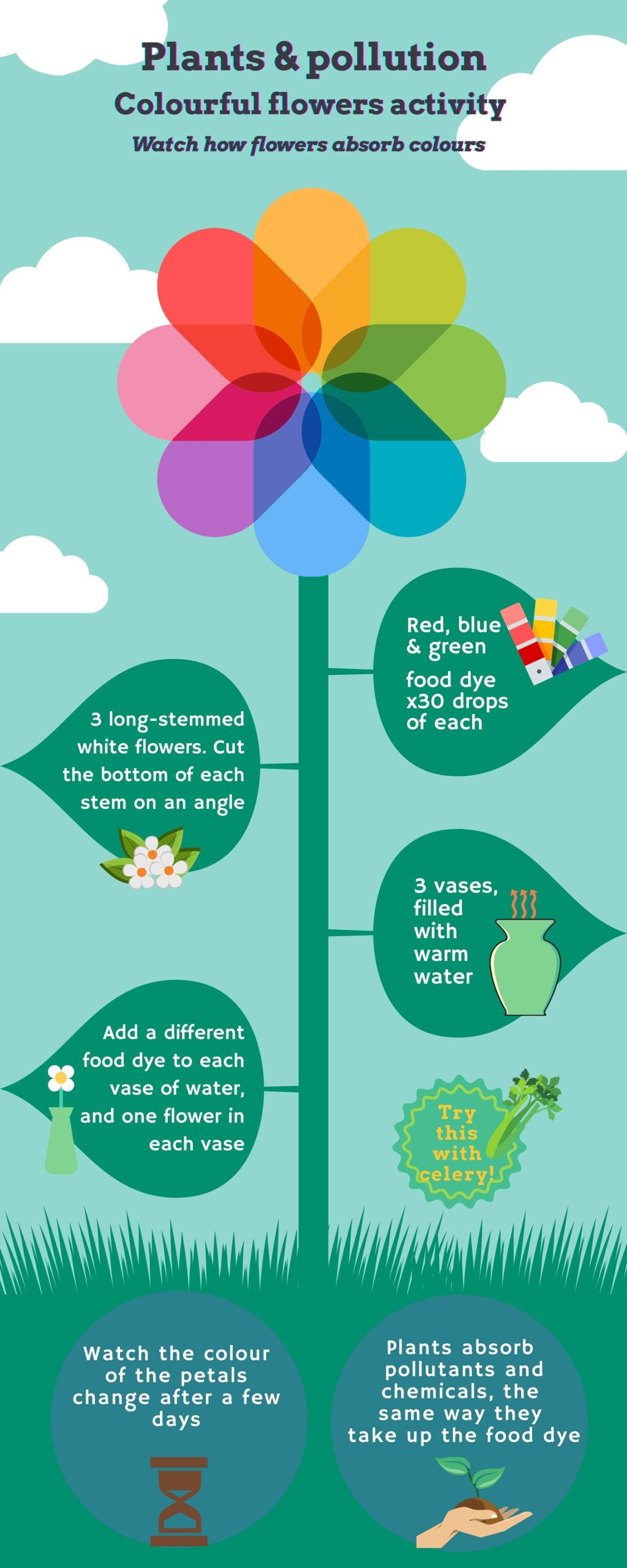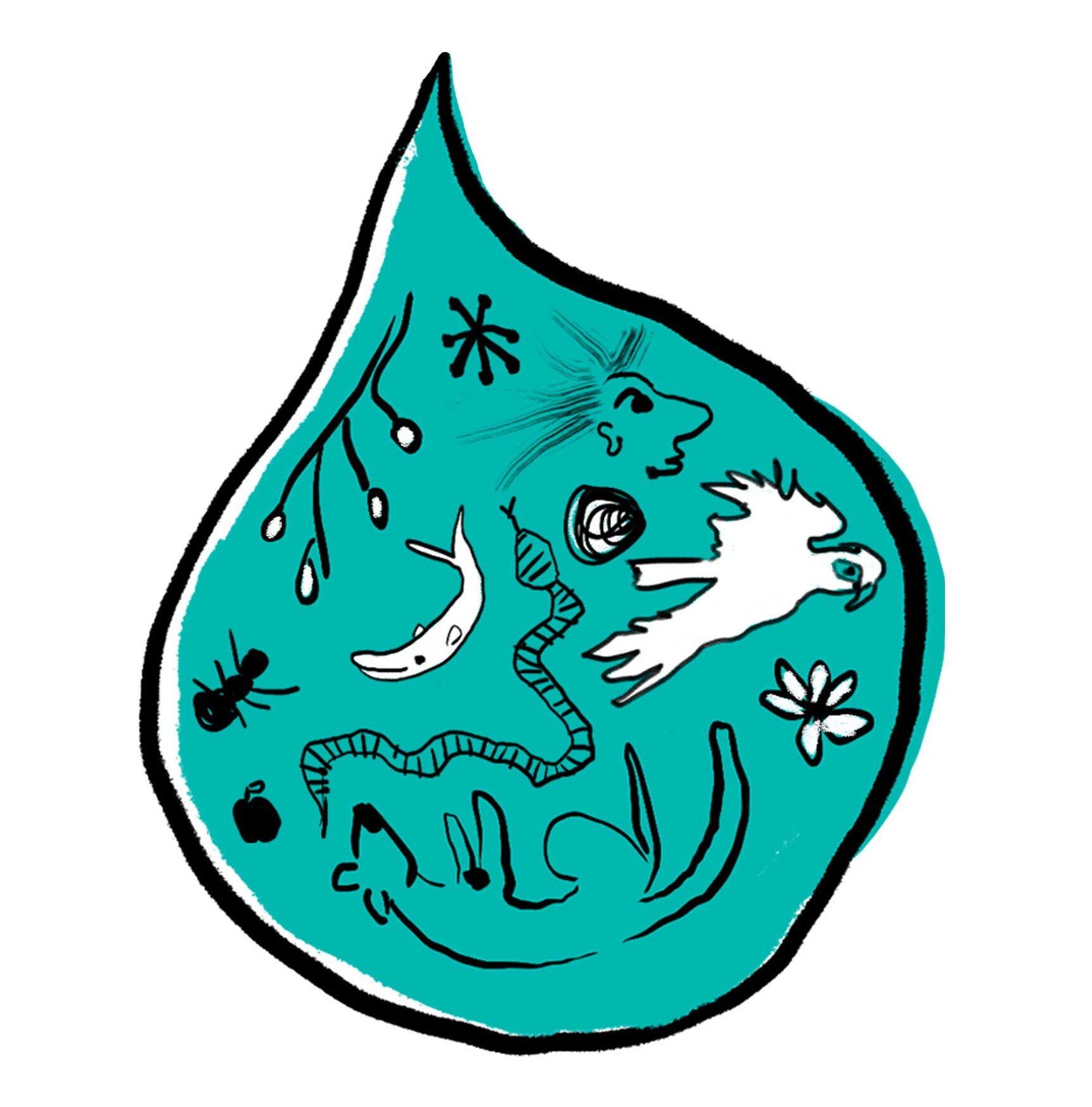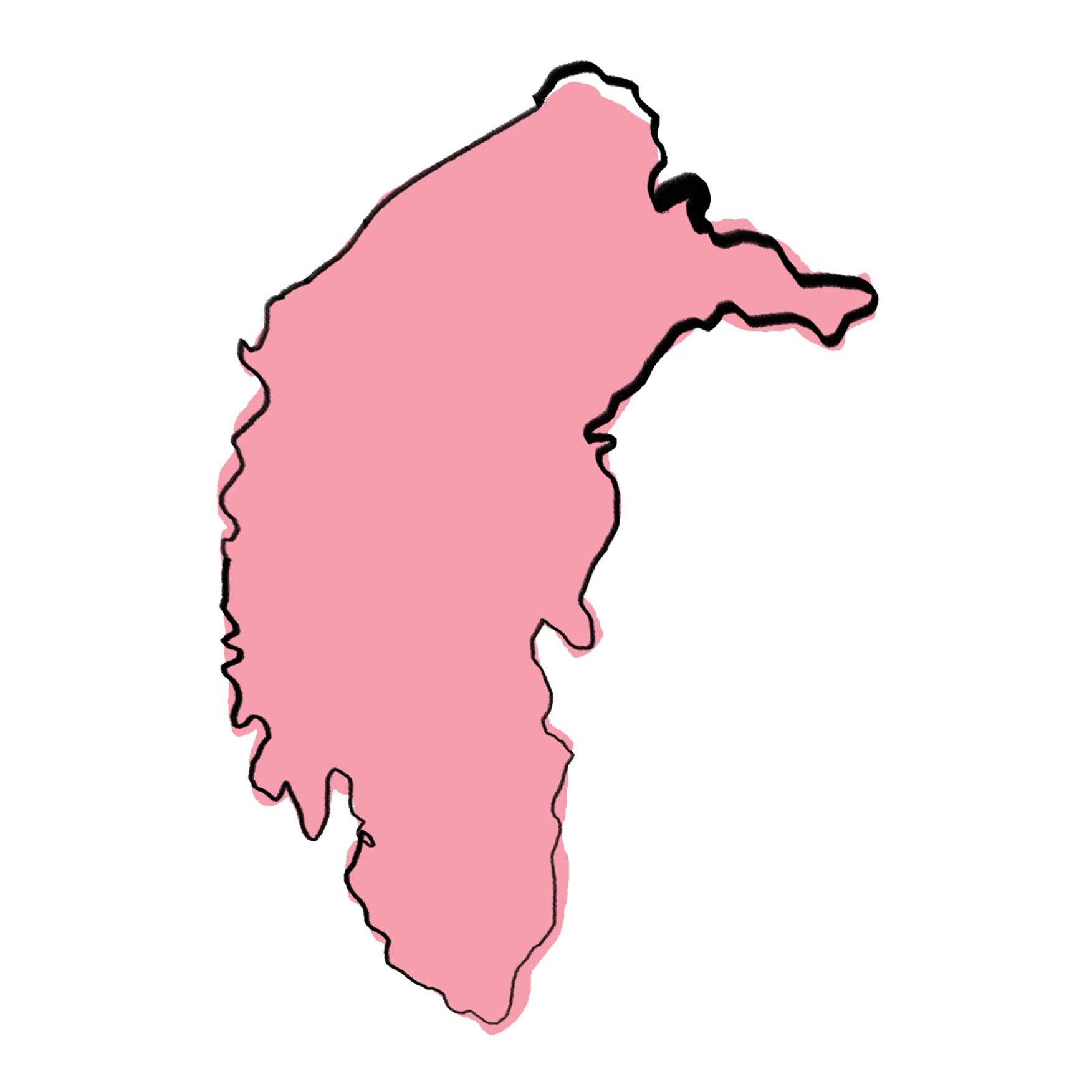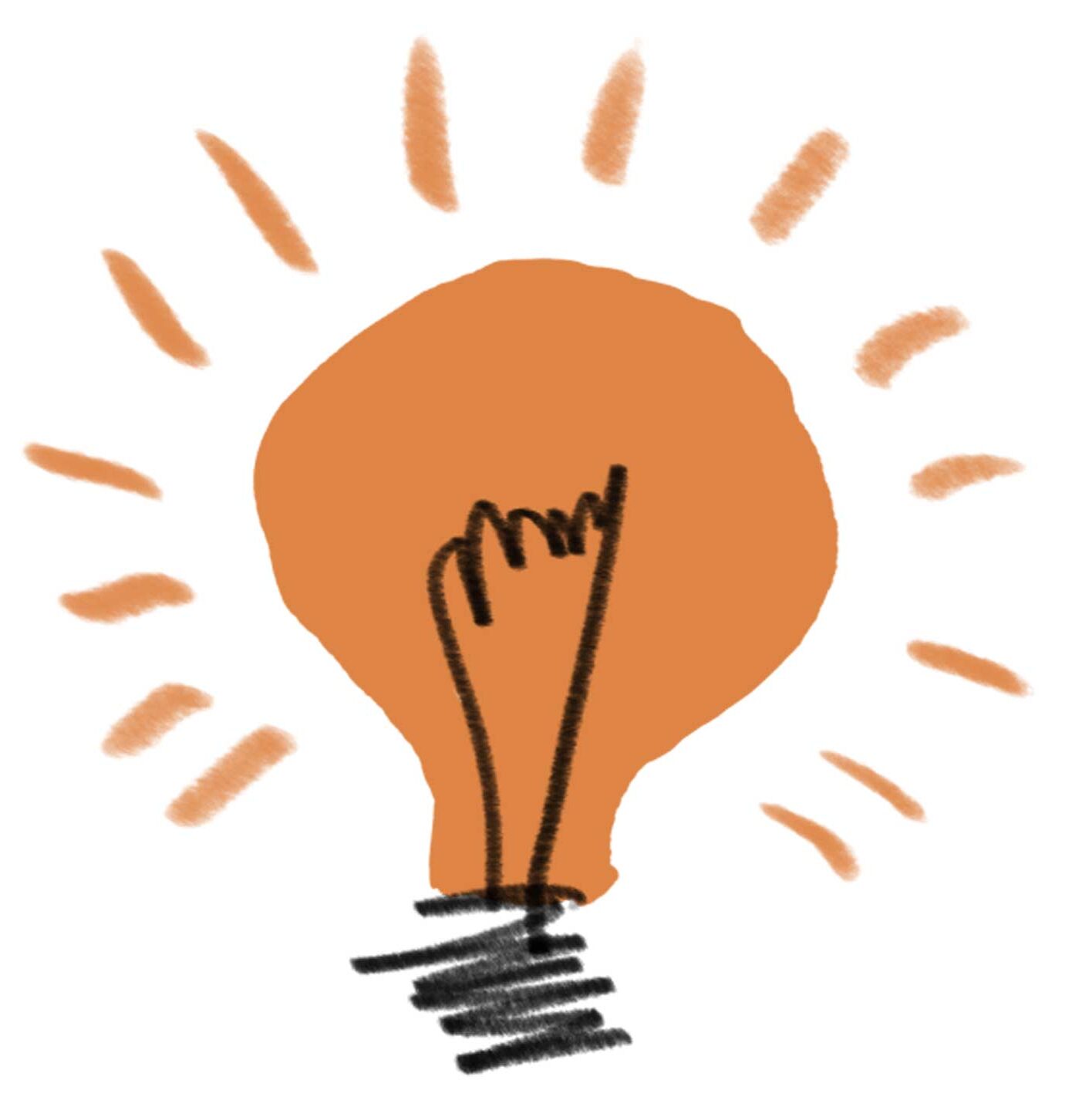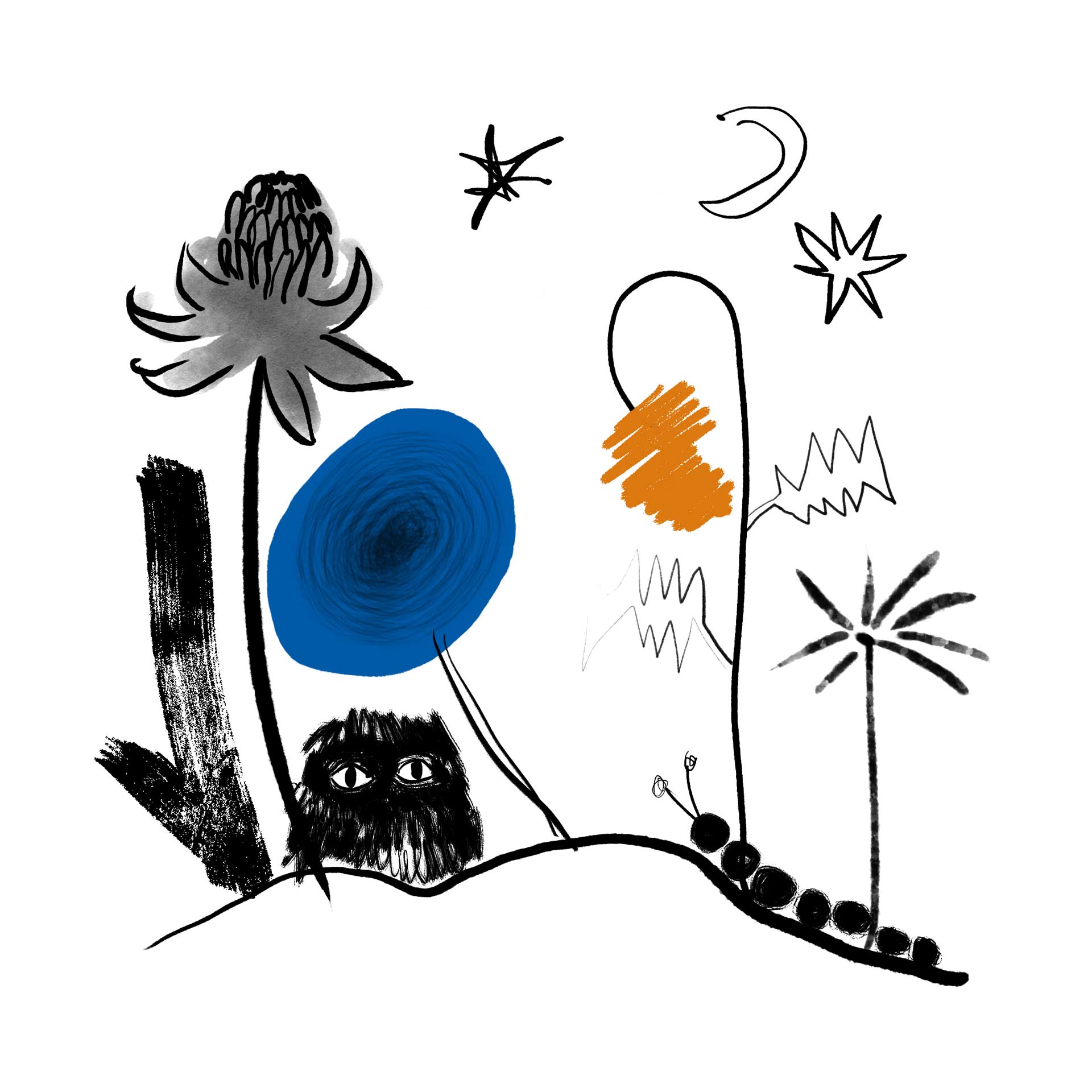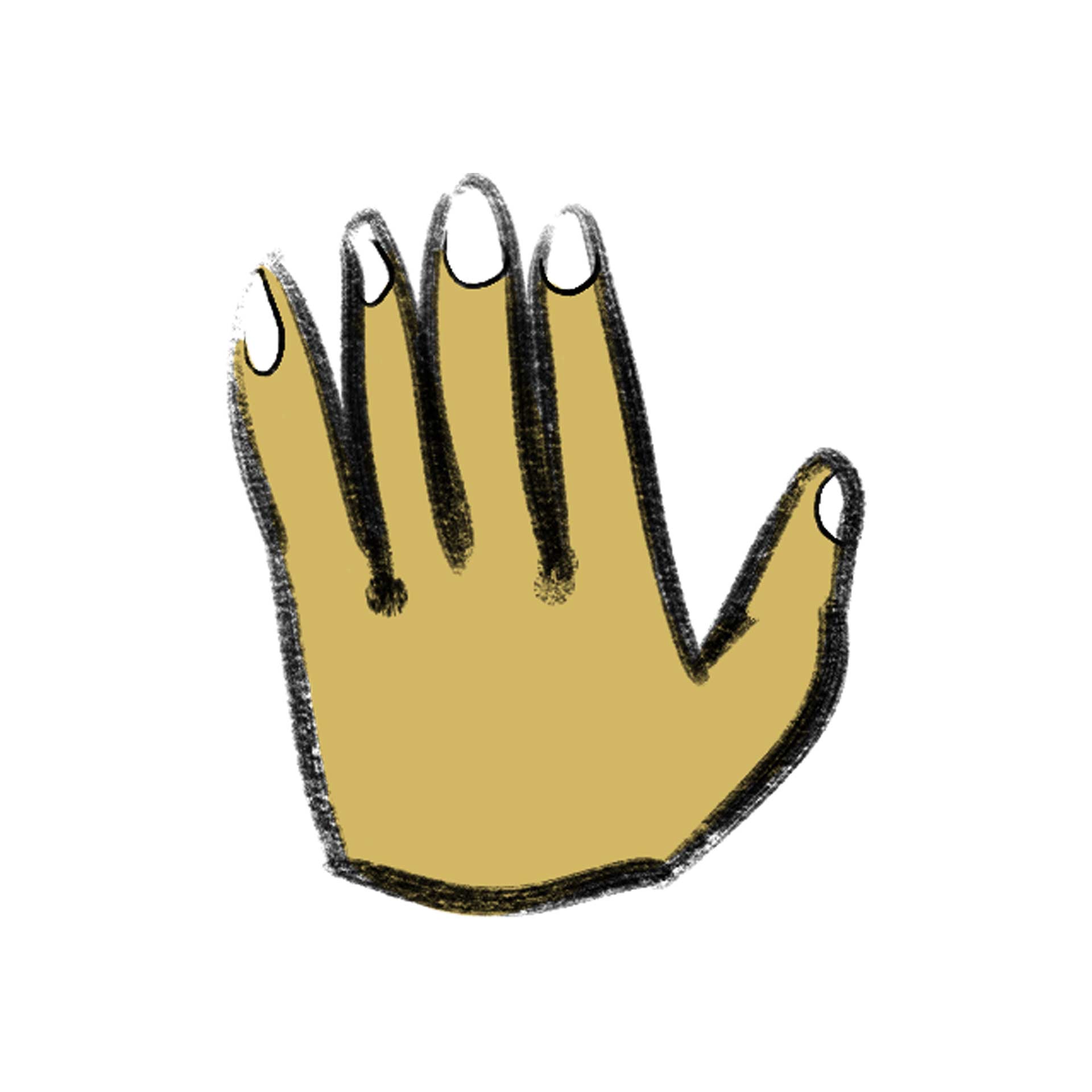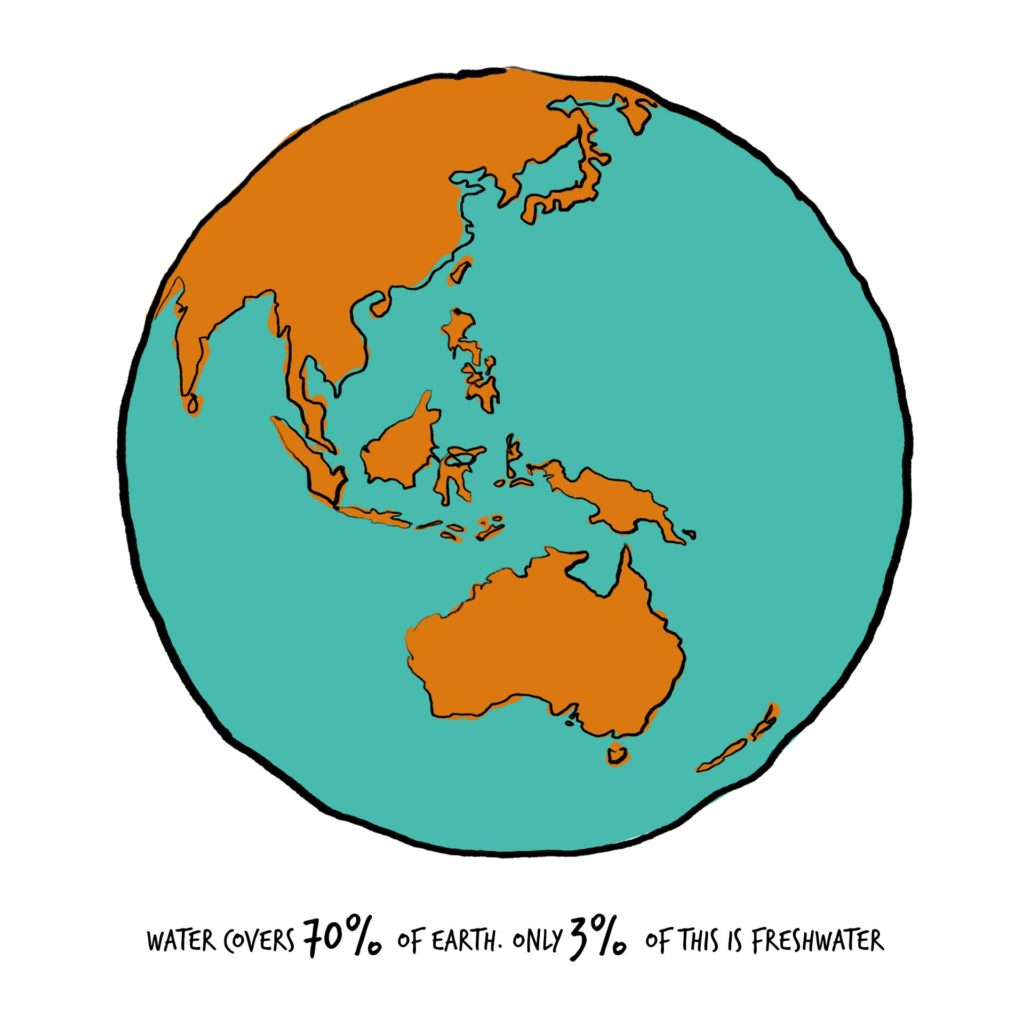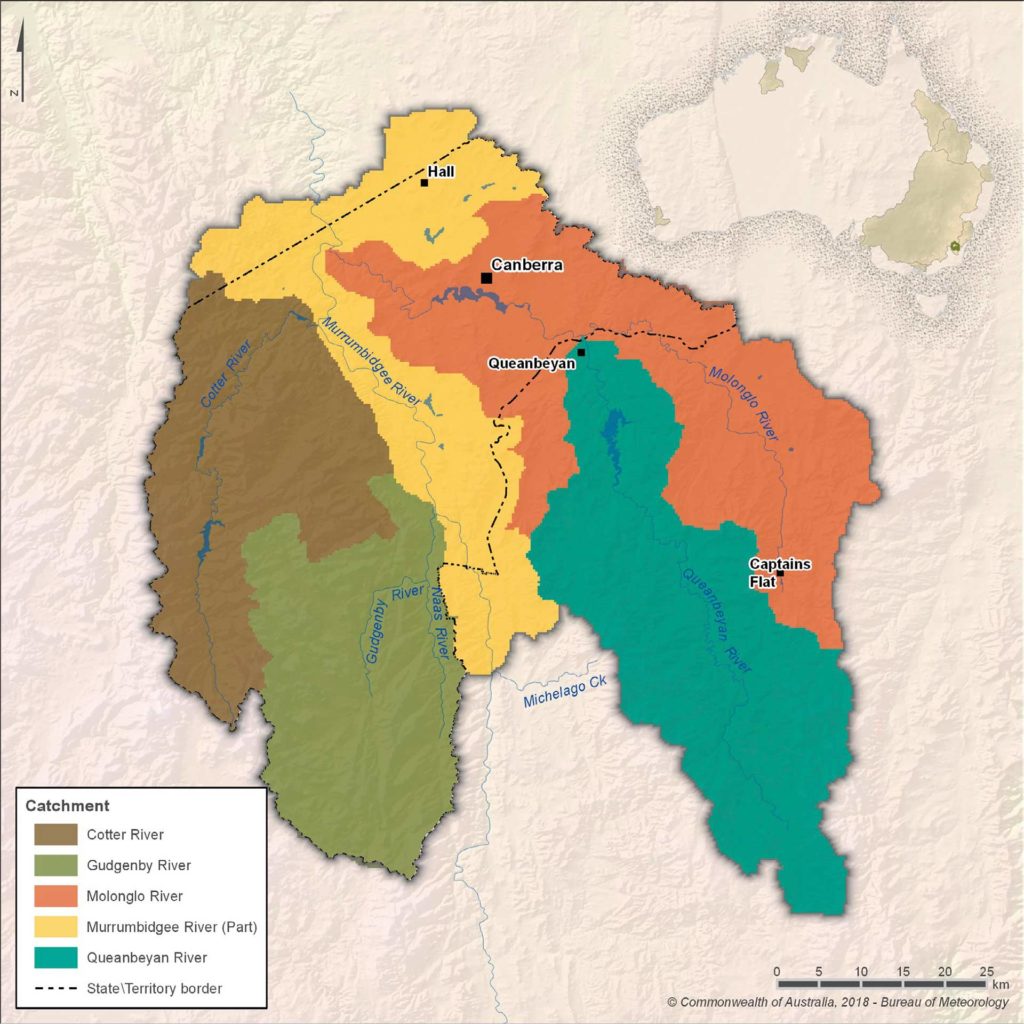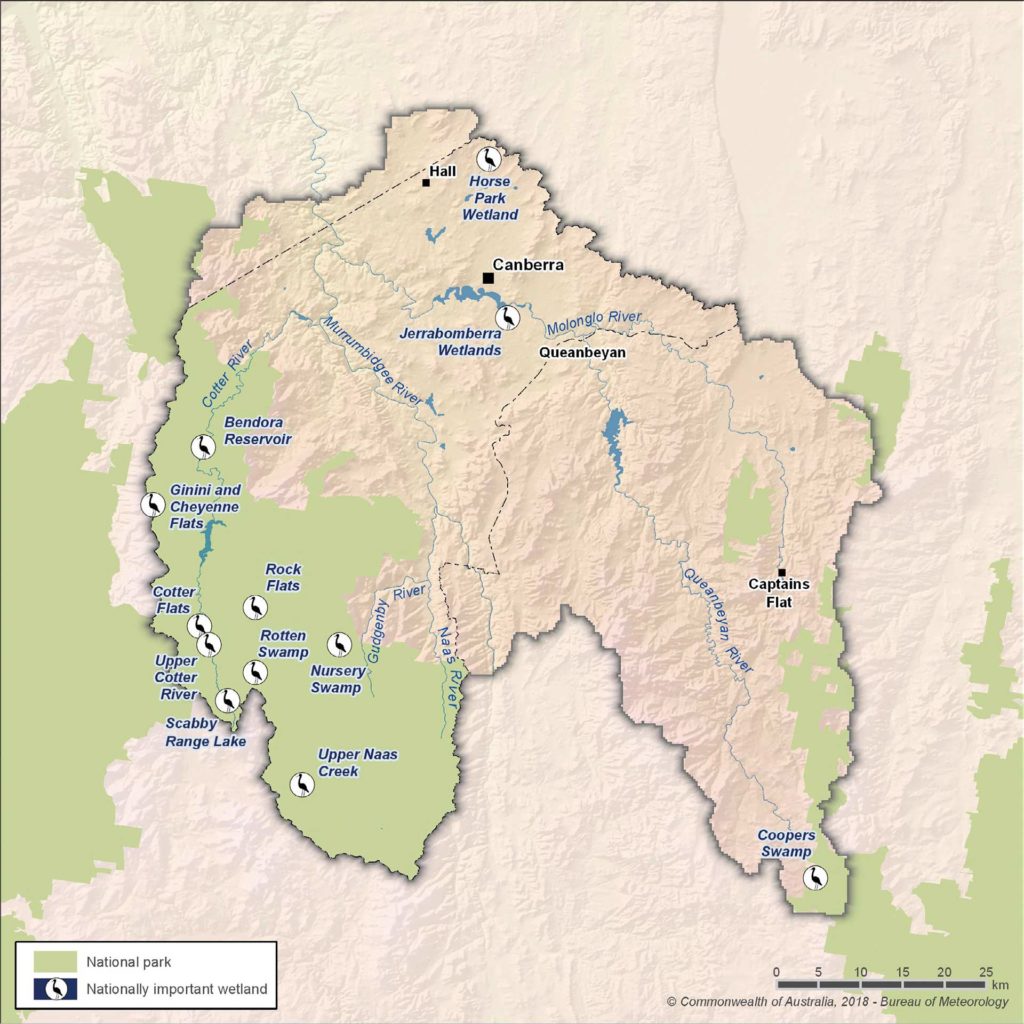Did you know all our waterways are connected? Let’s find out how healthy they are.
Click the links below to discover more!
Water is precious
Did you know that the water we have on Earth now is the same water that the dinosaurs drank?
We have a set amount of water on Earth: the amount of water doesn’t increase or decrease, it just moves through the atmosphere and the environment (this is known as the water cycle).
Water covers 70 per cent of the Earth’s surface, but most of this is saltwater in our oceans. Only about three per cent of the water on Earth is freshwaterWater in rivers, lakes, wetlands, and underground that is not salty., and most of this is either frozen, in the air, or underground. Less than one per cent of the Earth’s water is freshwaterWater in rivers, lakes, wetlands, and underground that is not salty. that is available for people and animals to use – which is why it is so precious.
Because of differences in rainfall, some places have lots of freshwaterWater in rivers, lakes, wetlands, and underground that is not salty., but in other places, such as deserts, there is almost none.
It is important that our water is clean and that there is enough of it for:
- plants and animals
- people (for drinking, growing food, washing, and having fun – like swimming or boating)
- cultural reasons – the Murrumbidgee River (and other rivers in the ACT) represent Songlines and Dreamings for the Ngunnawal people.
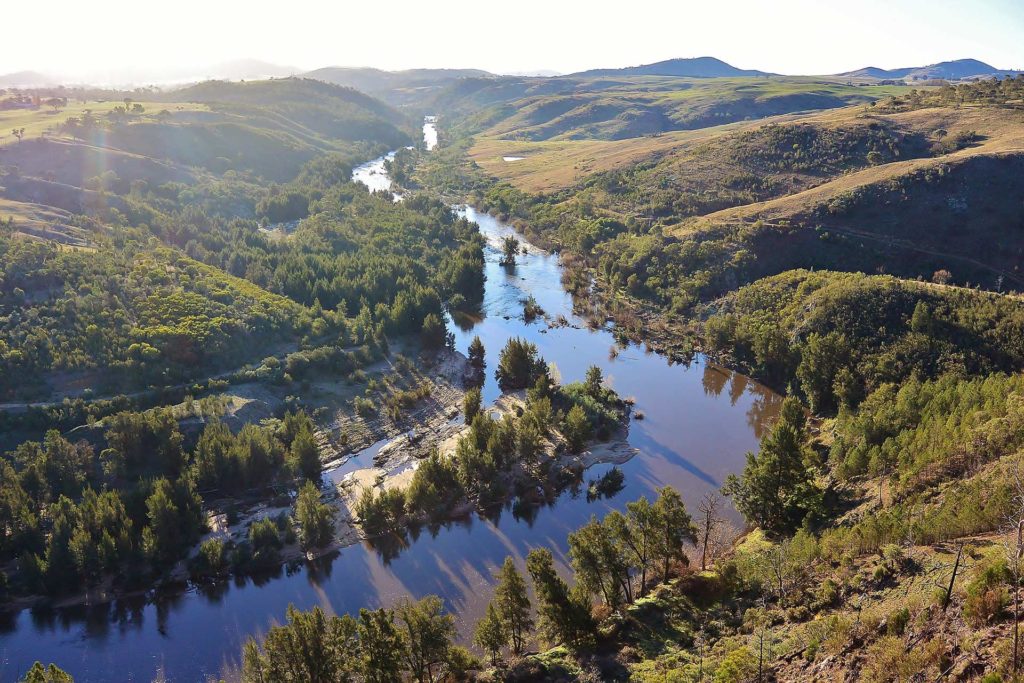
ACT’S RIVERS, LAKES AND WETLANDS
The ACT’s largest river is the Murrumbidgee, which means ‘big water’ in the language of the Ngunnawal people, the first inhabitants of the land on which Canberra is located. This river begins in the NSW mountains and runs through the ACT. The Murrumbidgee is the second longest river in Australia!
Some other rivers in the ACT are the:
- Cotter River
- Gudgenby River
- Molonglo River
- Paddys River
Image: Murrumbidgee River, Photo: Mark Jekabson
Canberra has 3 lakes – Lake Burley Griffin, Lake Ginninderra and Lake Tuggeranong. These are man-made or constructed lakes and did not exist before Canberra was developed. There are also many other constructed ponds and wetlandsAreas of land that are covered with shallow water or are waterlogged (wet). These can be seasonal, only existing for short periods of time, or can be permanent. in the Canberra area. These were mainly created to capture pollutionHarmful substances that can damage the environment. Water pollutants include chemicals, fertilisers, bacteria, viruses, animal or human waste, and too many nutrients. and stop it getting into our rivers.
The ACT has 12 nationally important wetlandsAreas of land that are covered with shallow water or are waterlogged (wet). These can be seasonal, only existing for short periods of time, or can be permanent. and the Ramsar-listed Ginini Flats Wetland Complex in the Namadgi National Park. Ramsar wetlandsAreas of land that are covered with shallow water or are waterlogged (wet). These can be seasonal, only existing for short periods of time, or can be permanent. are those that have been recognised across the world as being very important because they are rare, unique, or home to lots of species. All wetlandsAreas of land that are covered with shallow water or are waterlogged (wet). These can be seasonal, only existing for short periods of time, or can be permanent. are important for conserving biodiversityAll of the different types of life in the environment. It includes plants, animals, and micro-organisms (really small things like bacteria and fungi)..
Do you know this waterway?
Click to find out!
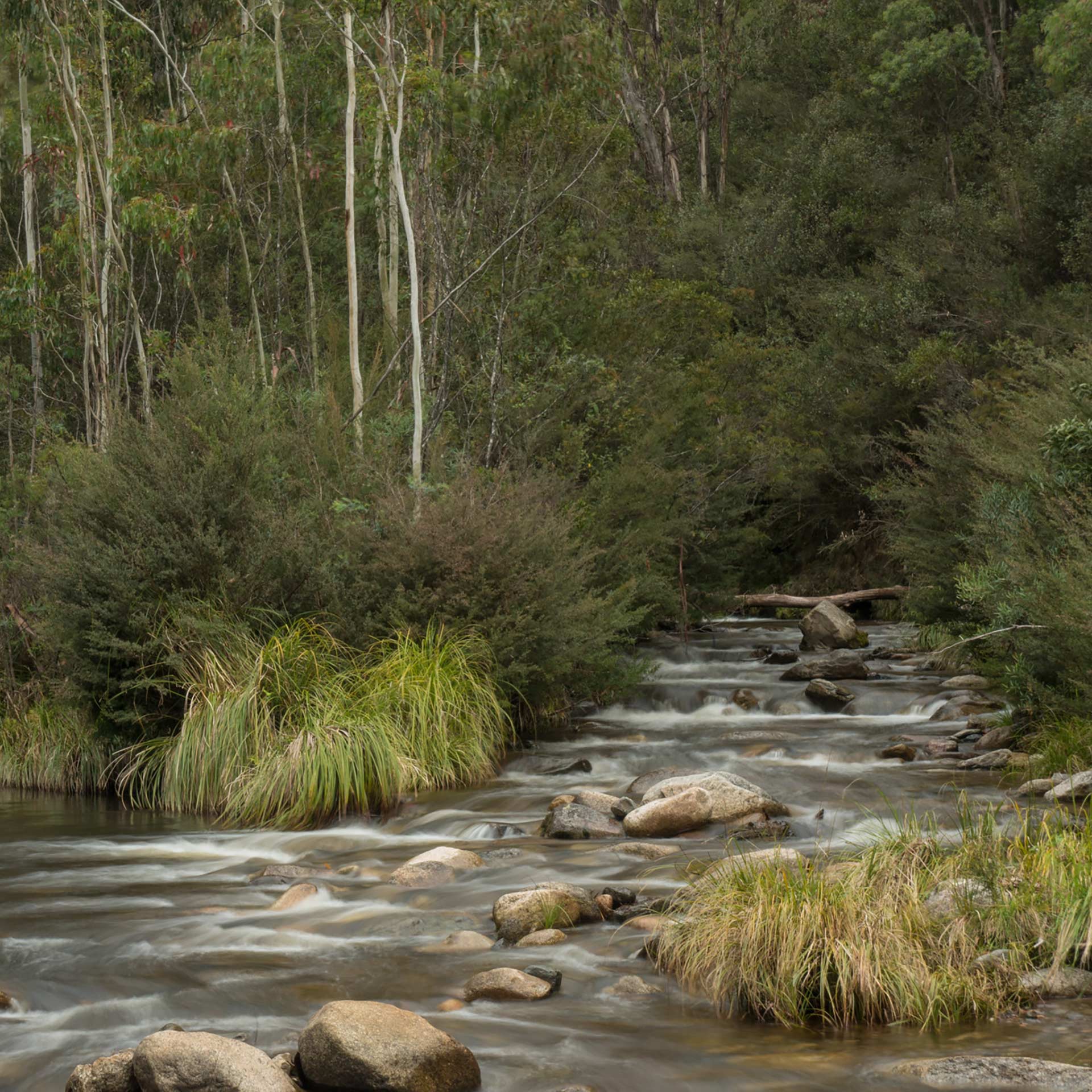
The Cotter River
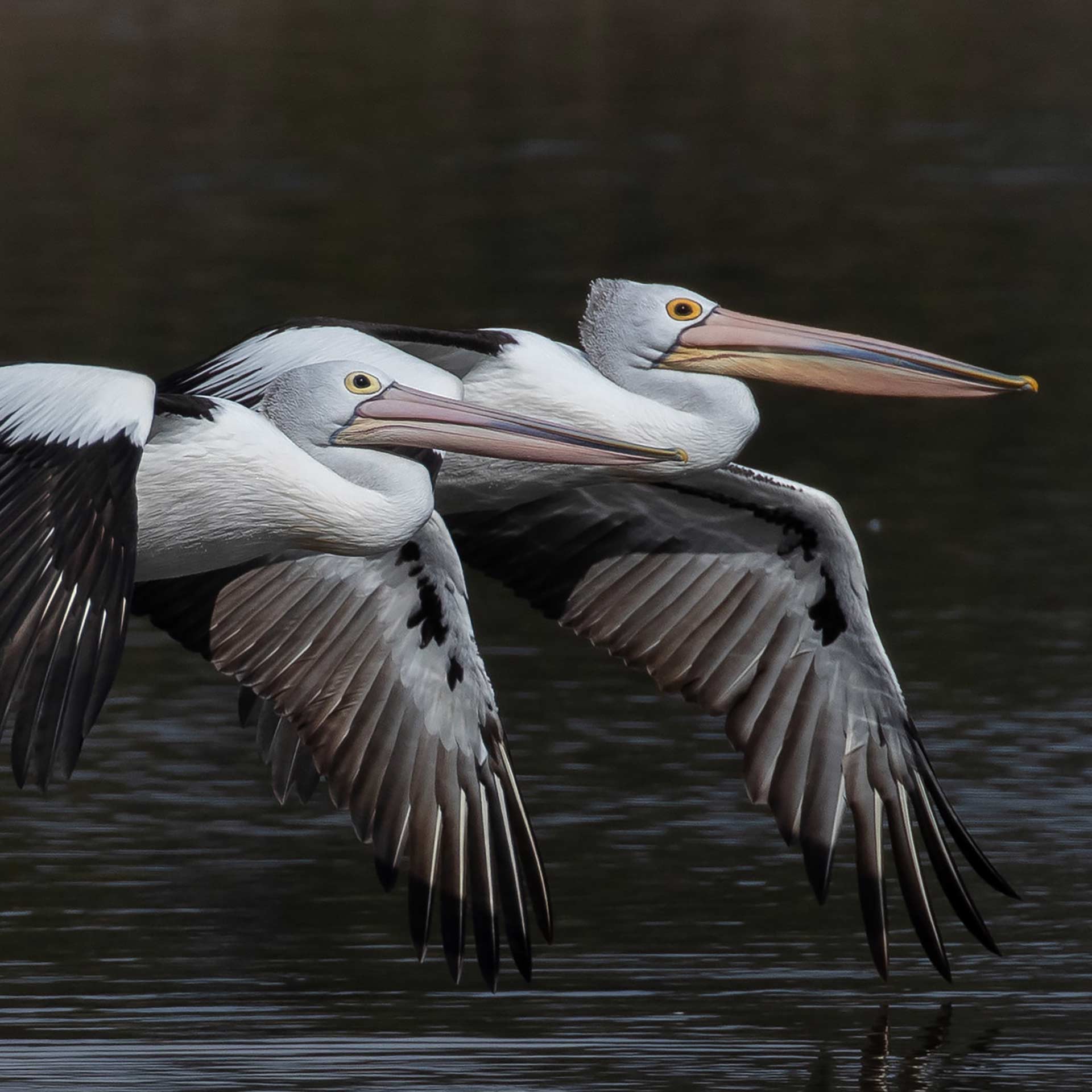
Jerrabomberra Wetlands
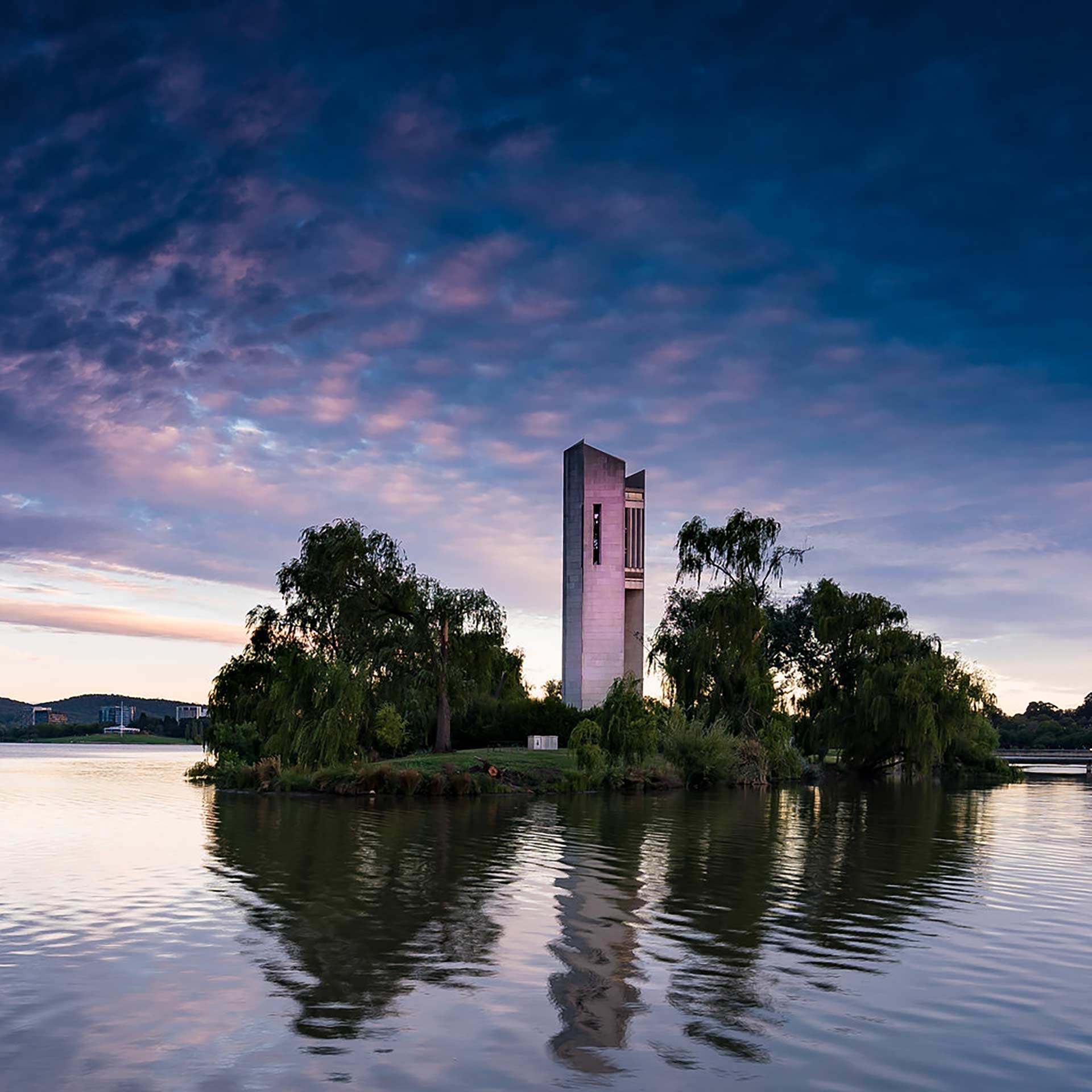
Lake Burley Griffin
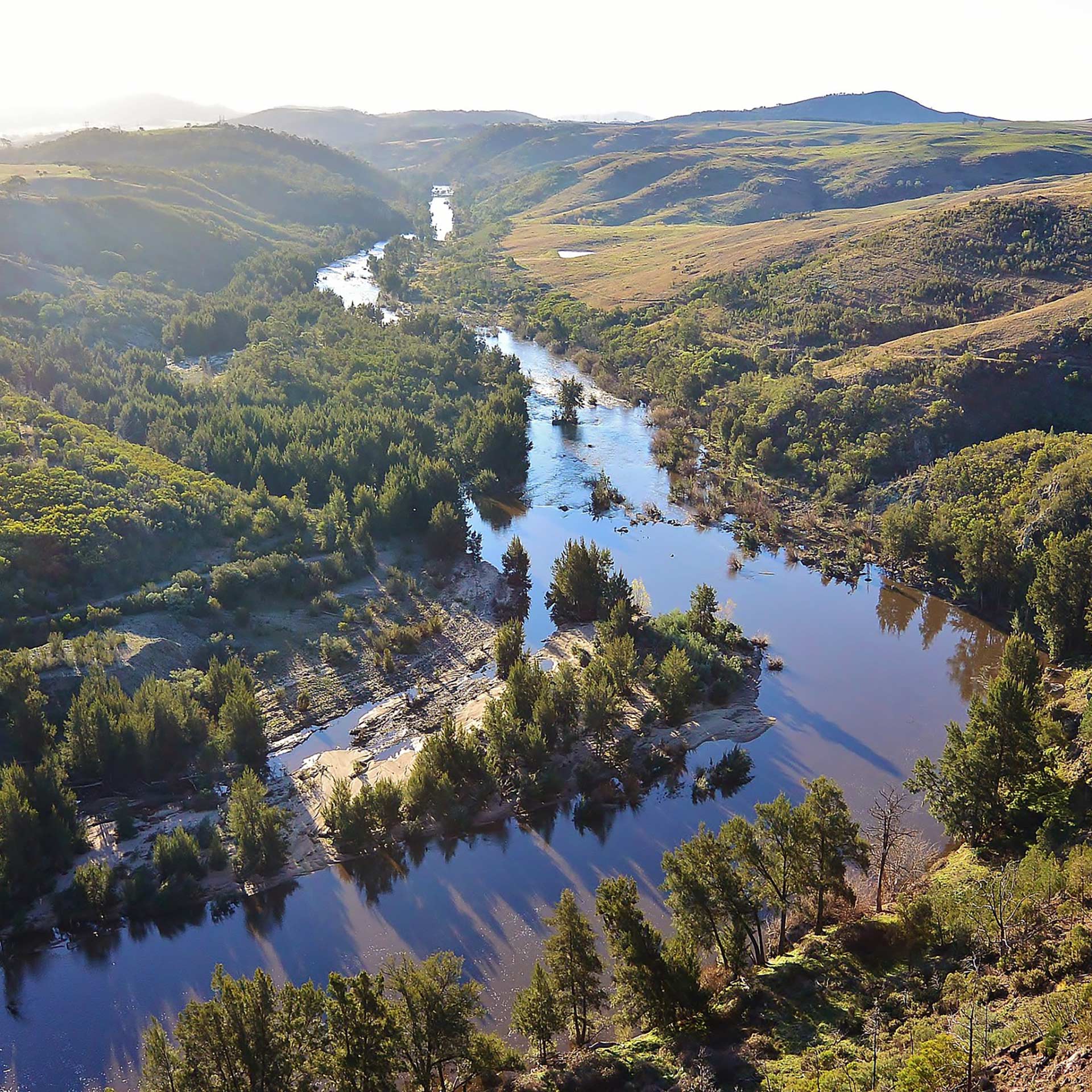
The Murrumbidgee River
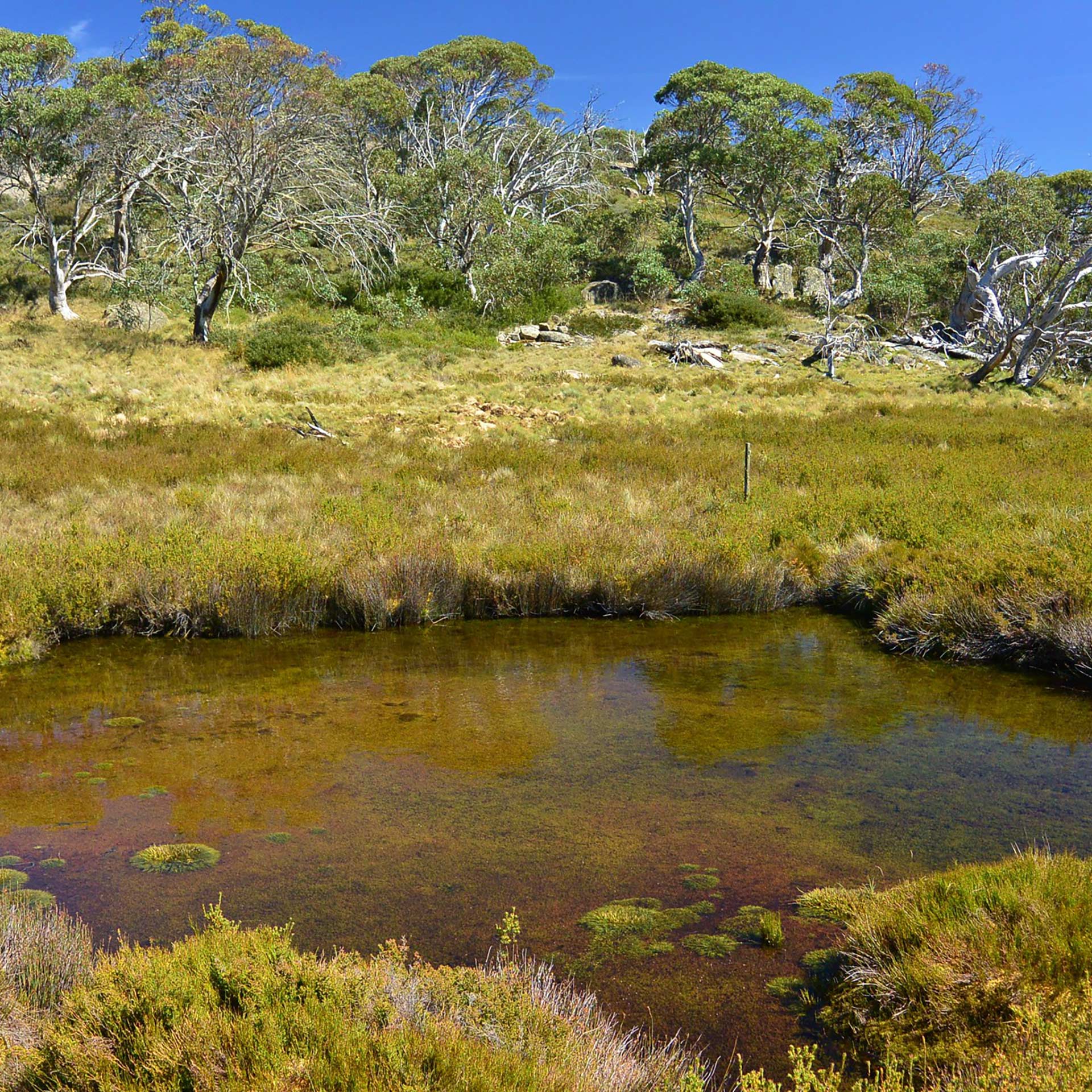
Ginini Flats Wetland
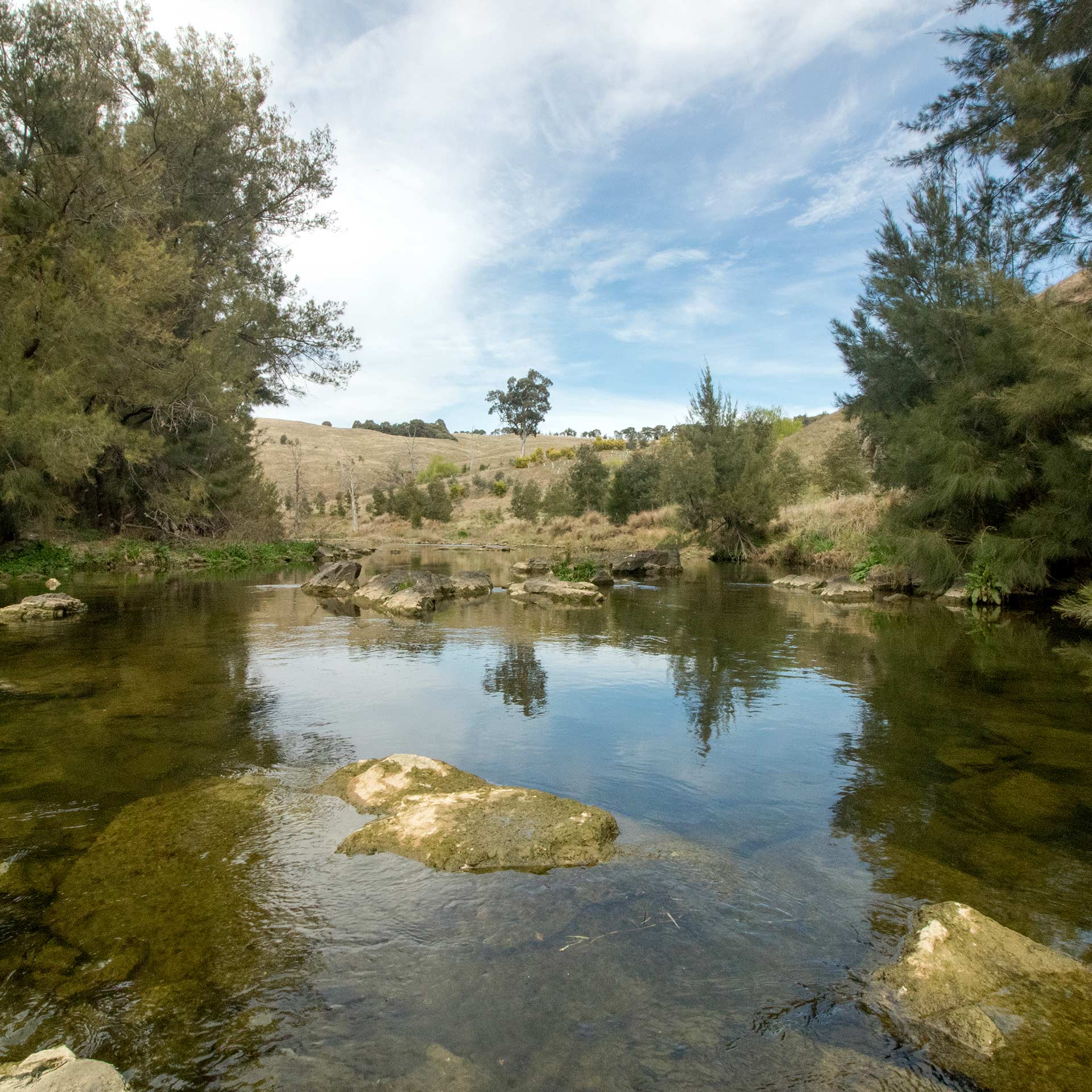
The Molonglo River
Images: Jerrabomberra wetlandsAreas of land that are covered with shallow water or are waterlogged (wet). These can be seasonal, only existing for short periods of time, or can be permanent. by Raw Shorty, Lake Burley Griffin by Jerry Skinner, Cotter and Murrumbidgee Rivers and Ginini Flats Wetland by Mark Jekabsons, Molonglo River by Ryan Colley
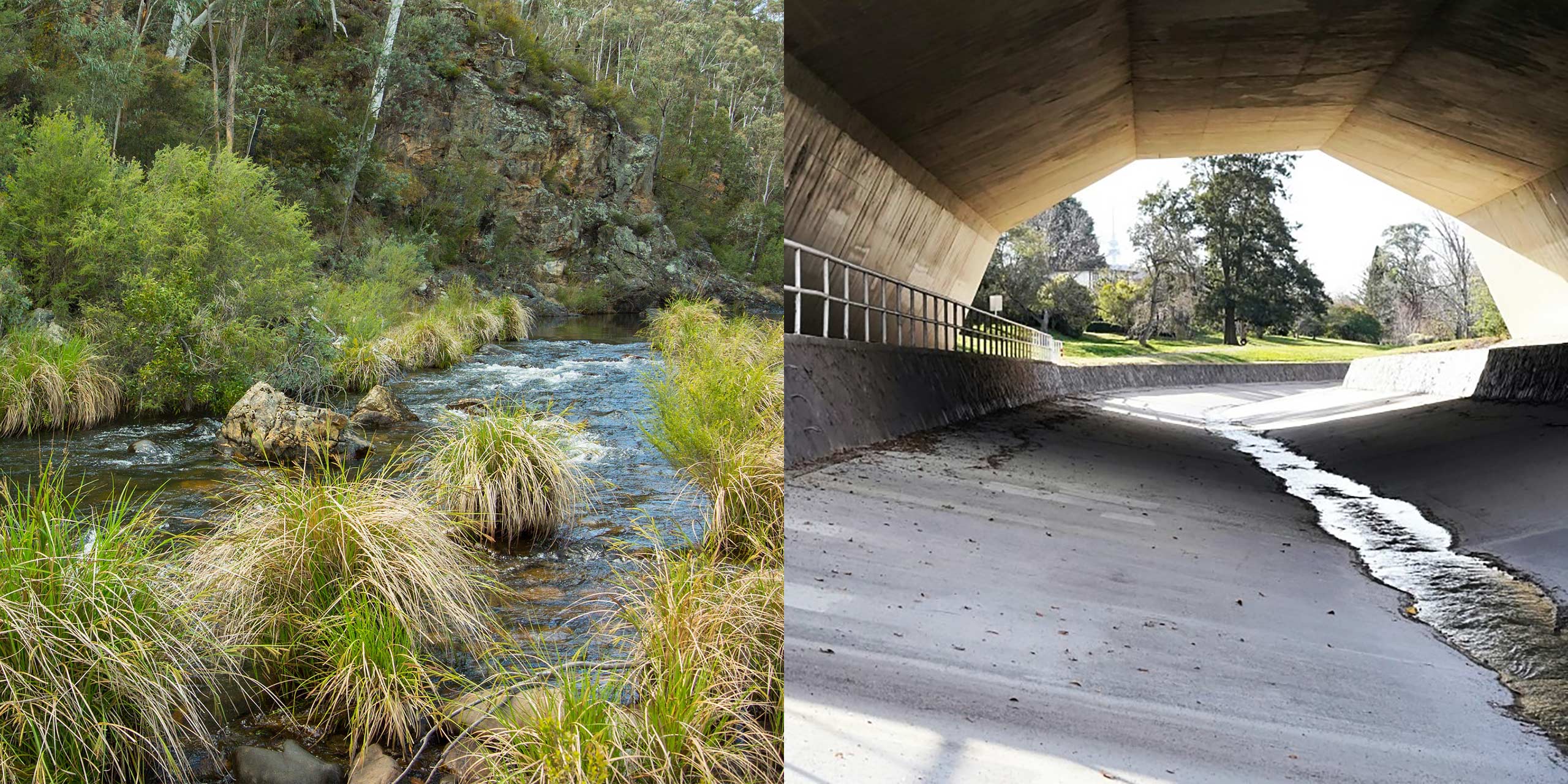
Image: Cotter River by Mark Jekabsons | Canberra Drain
Healthy rivers, lakes and wetlands
We need to keep our rivers, lakes and wetlands healthy so people and the animals that live there have clean water. Water can be contaminated by pollutants – when we measure the pollutants in a waterway, it is called measuring the water quality.
Rivers, lakes and wetlandsAreas of land that are covered with shallow water or are waterlogged (wet). These can be seasonal, only existing for short periods of time, or can be permanent. also need plants, because plants help keep waterways clean. Riparian vegetationPlants on the riverbanks, lake edges and around wetlands. help keep waterways clean by acting like a filter for nutrientsElements such as nitrogen and phosphorus. Too many nutrients in water can cause large amounts of algae to grow harming other plants and animals., sedimentParticles of dirt, rocks, and dead plant or dead animal matter. Too much sediment in water can harm plants and animals. and other pollutantsHarmful substances that can damage the environment. Water pollutants include chemicals, fertilisers, bacteria, viruses, animal or human waste, and too many nutrients.. These are carried in water running off urbanAreas of land that have been built on to create a city or town. areas such as concrete and roads, or off farm paddocks that have livestock (sheep and cows) or use chemicals to help crops grow. When pollutantsHarmful substances that can damage the environment. Water pollutants include chemicals, fertilisers, bacteria, viruses, animal or human waste, and too many nutrients. are washed into rivers, wetlandsAreas of land that are covered with shallow water or are waterlogged (wet). These can be seasonal, only existing for short periods of time, or can be permanent. and lakes they affect the species living there. A healthy river also needs enough water flowing along it. This not only provides the habitatThe natural home or environment of a plant or animal. that plants and animals need, but also helps to keep oxygen in the water for the animals that live in it.
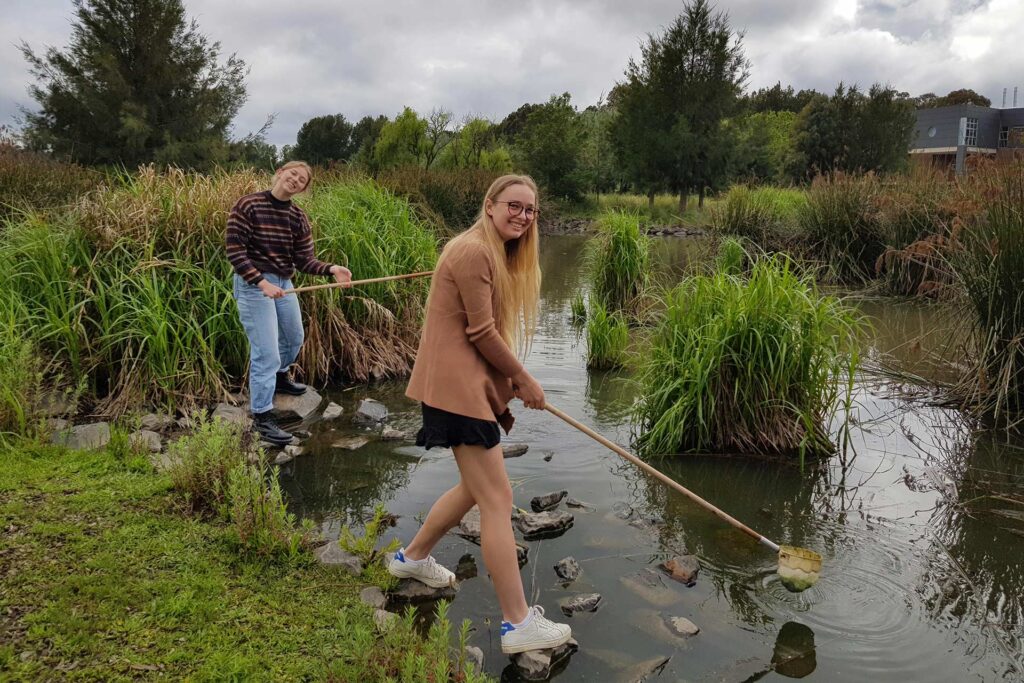
HOW HEALTHY ARE OUR RIVERS, LAKES AND WETLANDS?
How do we measure the health of rivers, lakes and wetlands?
There are different ways to measure the health of rivers, lakes and wetlandsAreas of land that are covered with shallow water or are waterlogged (wet). These can be seasonal, only existing for short periods of time, or can be permanent., including:
- measuring biodiversityAll of the different types of life in the environment. It includes plants, animals, and micro-organisms (really small things like bacteria and fungi). – the types of plants and animals that live in the water, even little things like water insects (these are called macroinvertebrates). Healthy rivers, lakes and wetlandsAreas of land that are covered with shallow water or are waterlogged (wet). These can be seasonal, only existing for short periods of time, or can be permanent. will have lots of nativeAnimals and plants that live in, and are originally from, an area. The area could be large, like Australia, or it could be small, like a specific national park. species in the water, and along their banks and edges.
- measuring river flow – how much water is flowing in the rivers. Rivers, lakes and wetlandsAreas of land that are covered with shallow water or are waterlogged (wet). These can be seasonal, only existing for short periods of time, or can be permanent. need to have enough water to stay healthy and to support plants and animals.
- measuring water qualityHow clean the water is in rivers, lakes and wetlands. Good water quality has low levels of pollutants. – healthy water is free from pollutionHarmful substances that can damage the environment. Water pollutants include chemicals, fertilisers, bacteria, viruses, animal or human waste, and too many nutrients. that can harm plants and animals. Where water is used for recreation (fun activities like swimming, canoeing and fishing), we can also test whether water contains bacteria, blue-green algae or chemicals that could make people sick.
By looking at all these measurements, we can assess the health of the ACT’s rivers, lakes and wetlandsAreas of land that are covered with shallow water or are waterlogged (wet). These can be seasonal, only existing for short periods of time, or can be permanent..
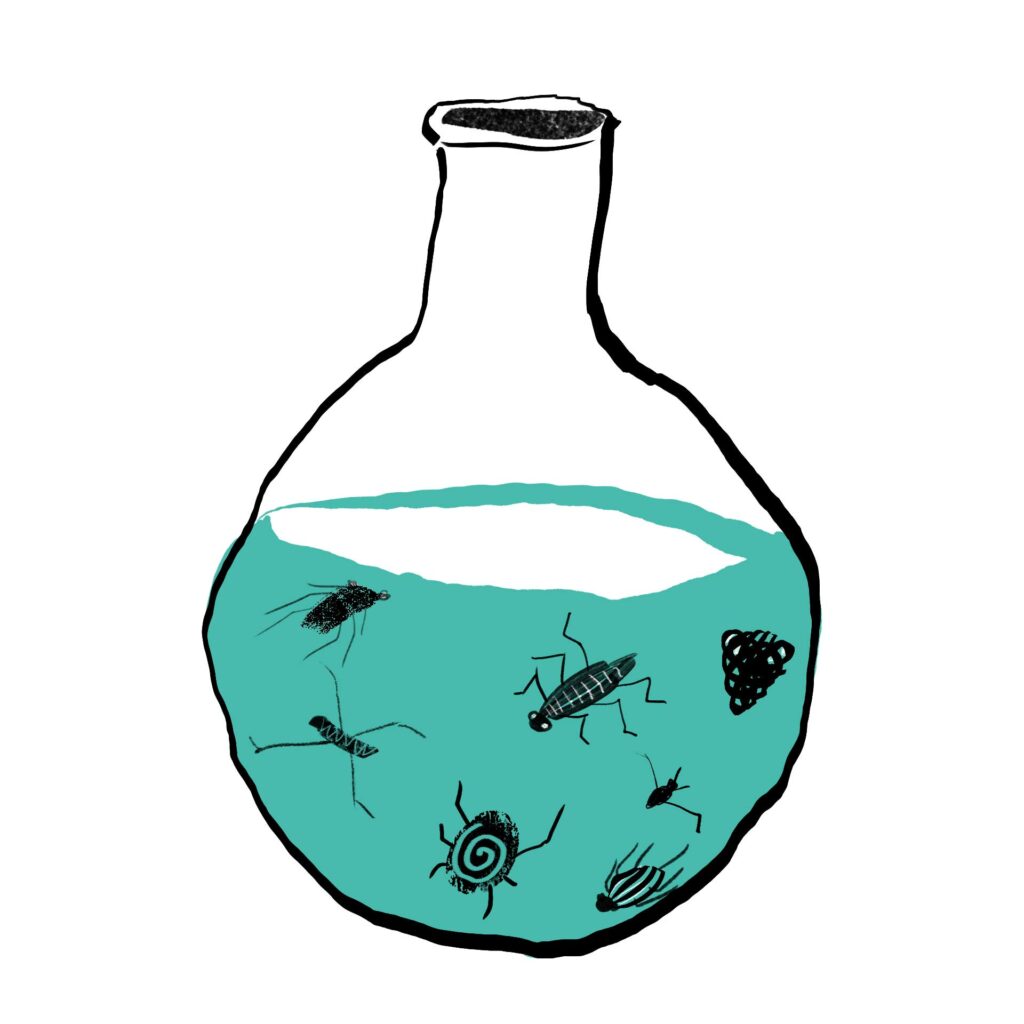
ARE ACT’S RIVERS, LAKES AND WETLANDS HEALTHY?
The overall health of the ACT’s rivers and creeks depends on where they are. Rivers in conservation areas (parks and reserves) are mostly in good health because there are lots of trees and other plants which keep the water clean.
But rivers near urban areas and farms are less heathy. This is because most of the plants in these areas have been removed.
River flow changes are also impacting on the ACT’s rivers and wetlandsAreas of land that are covered with shallow water or are waterlogged (wet). These can be seasonal, only existing for short periods of time, or can be permanent.. Because of climateThe usual weather that happens in an area over a long time, usually many years. Climate change is when this usual weather changes. change, there is now less rainfall and less water available for our rivers and wetlandsAreas of land that are covered with shallow water or are waterlogged (wet). These can be seasonal, only existing for short periods of time, or can be permanent.. When there is less water for long periods of time, plants and animals can suffer as their food and habitats are lost.
water qualityHow clean the water is in rivers, lakes and wetlands. Good water quality has low levels of pollutants. is mostly good in the ACT, even in rural (farming areas) and urbanAreas of land that have been built on to create a city or town. areas! But our recreational water qualityHow clean the water is in areas used for recreation (activities like swimming, canoeing and fishing). Good recreational water quality has low levels of bacteria and blue-green algae which can make people sick. can be poor. In the summer, recreational areas in our lakes and rivers can be closed because there is too much blue-green algae and bacteria in the water. These can make people sick if they get the water on their skin or if they accidently swallow the water. Most of the recreational and other water qualityHow clean the water is in rivers, lakes and wetlands. Good water quality has low levels of pollutants. problems are from the pollutantsHarmful substances that can damage the environment. Water pollutants include chemicals, fertilisers, bacteria, viruses, animal or human waste, and too many nutrients. washed into rivers and lakes by rainfall. urbanAreas of land that have been built on to create a city or town. areas and rural areas are where most of the water pollutantsHarmful substances that can damage the environment. Water pollutants include chemicals, fertilisers, bacteria, viruses, animal or human waste, and too many nutrients. come from in the ACT.
Non-native, or invasivePlants and animals that are not native to Australia. These are also known as introduced species. fish species such as carp, rainbow trout, brown trout and redfin perch are also a problem in the ACT. In some rivers, there are far more invasivePlants and animals that are not native to Australia. These are also known as introduced species. fish than nativeAnimals and plants that live in, and are originally from, an area. The area could be large, like Australia, or it could be small, like a specific national park. fish. For example, up to 70 per cent of the fish in the Murrumbidgee River are invasivePlants and animals that are not native to Australia. These are also known as introduced species. species!
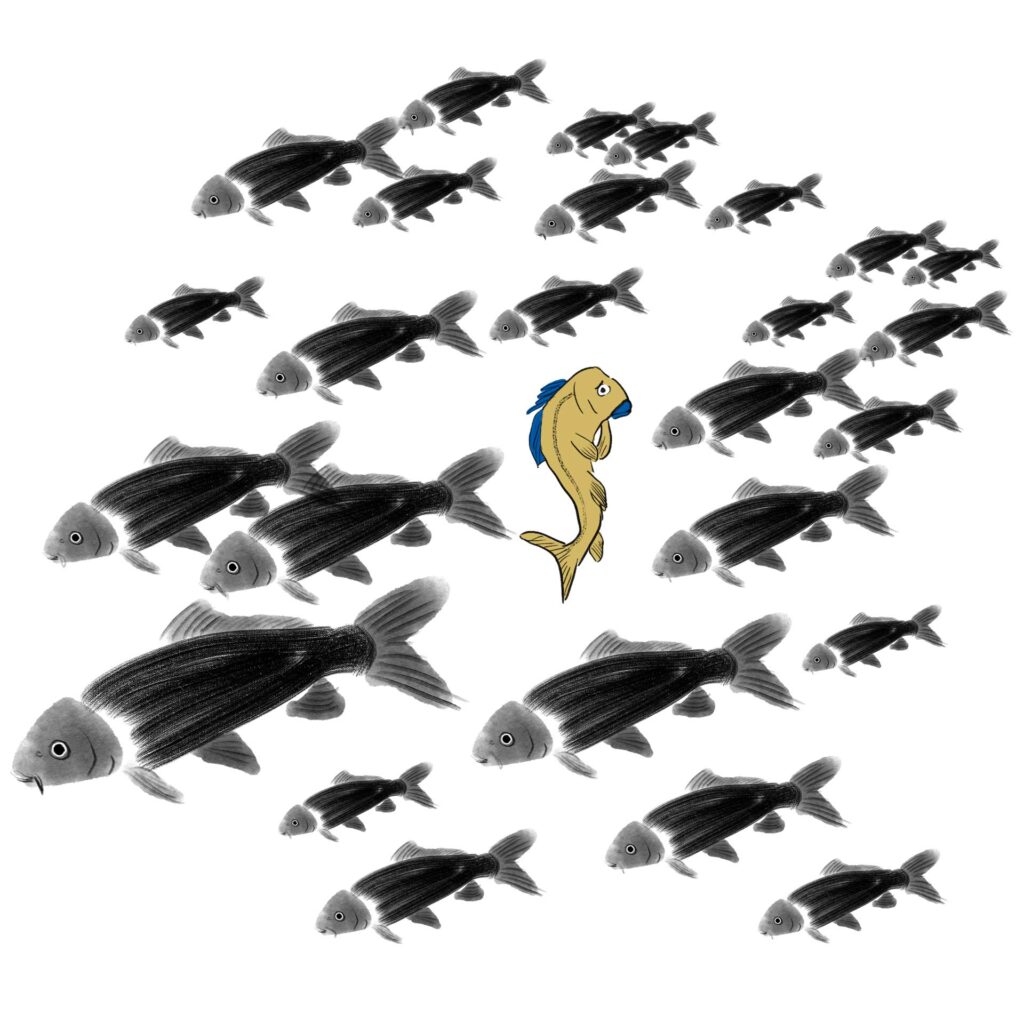
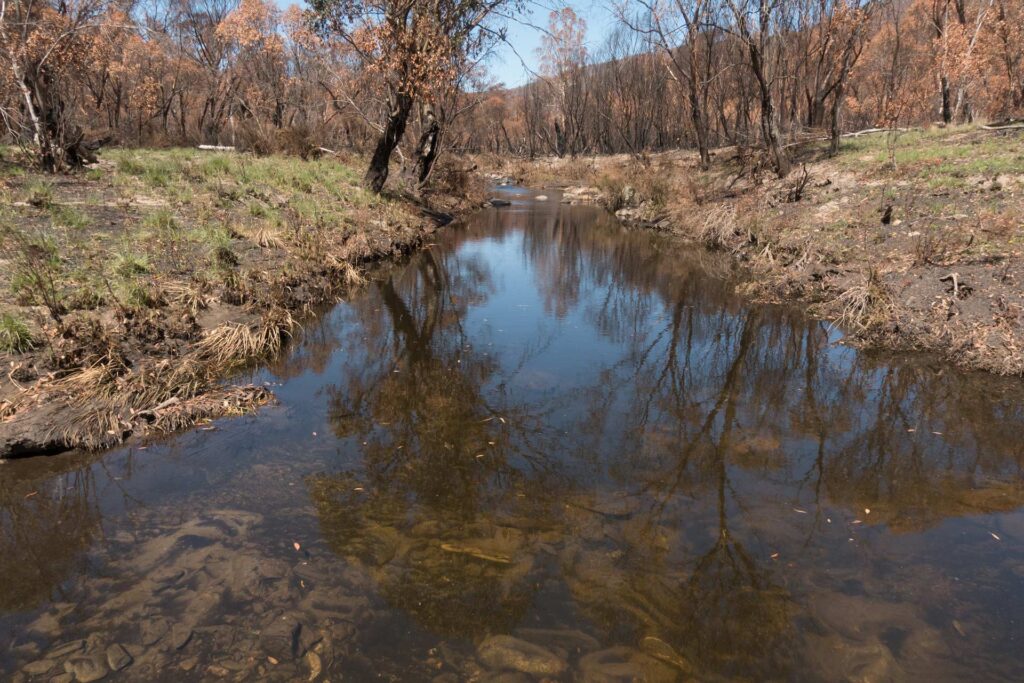
WHAT ARE THE MOST COMMON IMPACTS ON THE HEALTH OF THE ACT’S RIVERS, LAKES AND WETLANDS?
- BushfiresA fire that burns in grass, bush or woodland and can threaten life, property and the environment – after BushfiresA fire that burns in grass, bush or woodland and can threaten life, property and the environment, ash, soil and dead plants can be washed into rivers and wetlandsAreas of land that are covered with shallow water or are waterlogged (wet). These can be seasonal, only existing for short periods of time, or can be permanent.. This can lead to poor water qualityHow clean the water is in rivers, lakes and wetlands. Good water quality has low levels of pollutants. and the loss of plant and animal species. It can also impact on our drinking water reservoirs.
- climateThe usual weather that happens in an area over a long time, usually many years. Climate change is when this usual weather changes. change – the Earth is warming and there are longer, hotter, drier droughts. This means less water for the ACT’s rivers, lakes and wetlandsAreas of land that are covered with shallow water or are waterlogged (wet). These can be seasonal, only existing for short periods of time, or can be permanent. and the biodiversityAll of the different types of life in the environment. It includes plants, animals, and micro-organisms (really small things like bacteria and fungi). they support.
- invasivePlants and animals that are not native to Australia. These are also known as introduced species. species – high numbers of invasivePlants and animals that are not native to Australia. These are also known as introduced species. plants and animals compete for food and habitatThe natural home or environment of a plant or animal. with nativeAnimals and plants that live in, and are originally from, an area. The area could be large, like Australia, or it could be small, like a specific national park. species, and some invasivePlants and animals that are not native to Australia. These are also known as introduced species. species can kill and eat nativeAnimals and plants that live in, and are originally from, an area. The area could be large, like Australia, or it could be small, like a specific national park. animals.
- Clearing land for urbanAreas of land that have been built on to create a city or town. areas – land clearing removes the trees and other vegetation that help to keep rivers, lakes and wetlandsAreas of land that are covered with shallow water or are waterlogged (wet). These can be seasonal, only existing for short periods of time, or can be permanent. healthy. Development of urbanAreas of land that have been built on to create a city or town. areas also means more concrete surfaces which increase water pollutionHarmful substances that can damage the environment. Water pollutants include chemicals, fertilisers, bacteria, viruses, animal or human waste, and too many nutrients. and soil erosionWhen the soil is carried away by water or wind. Soil erosion can reduce biodiversity, harm rivers when soil is washed into waterways, and can create dust storms., and reduce habitatThe natural home or environment of a plant or animal. for plants and animals.
Image: Sedimentation from fires
WHAT CAN WE ALL DO TO HELP KEEP OUR RIVERS, LAKES AND WETLANDS HEALTHY?
- Use environmentally friendly dishwashing, shower and laundry soaps – think about the chemicals you are putting down the sink!
- Use less water. Have shorter showers, recycle water, do less washing, water the garden less, install a rainwater tank.
- Make sure that rubbish and garden waste goes in the bin or the compost – any litter dropped in the street can be washed or blown into our waterways.
- Plant more nativeAnimals and plants that live in, and are originally from, an area. The area could be large, like Australia, or it could be small, like a specific national park. vegetation to reduce the amount of pollutionHarmful substances that can damage the environment. Water pollutants include chemicals, fertilisers, bacteria, viruses, animal or human waste, and too many nutrients. going into our waters.
- Clean up fallen leaves and other debris from gardens and streets, so that this doesn’t wash into our waterways.
A hands-on way to help local waterways is to join a volunteer community group. You could join the community WaterWatch program where you help monitor water qualityHow clean the water is in rivers, lakes and wetlands. Good water quality has low levels of pollutants., water bugs and river plants. Collecting information about your local waterway helps scientists better understand water across the ACT and Australia.
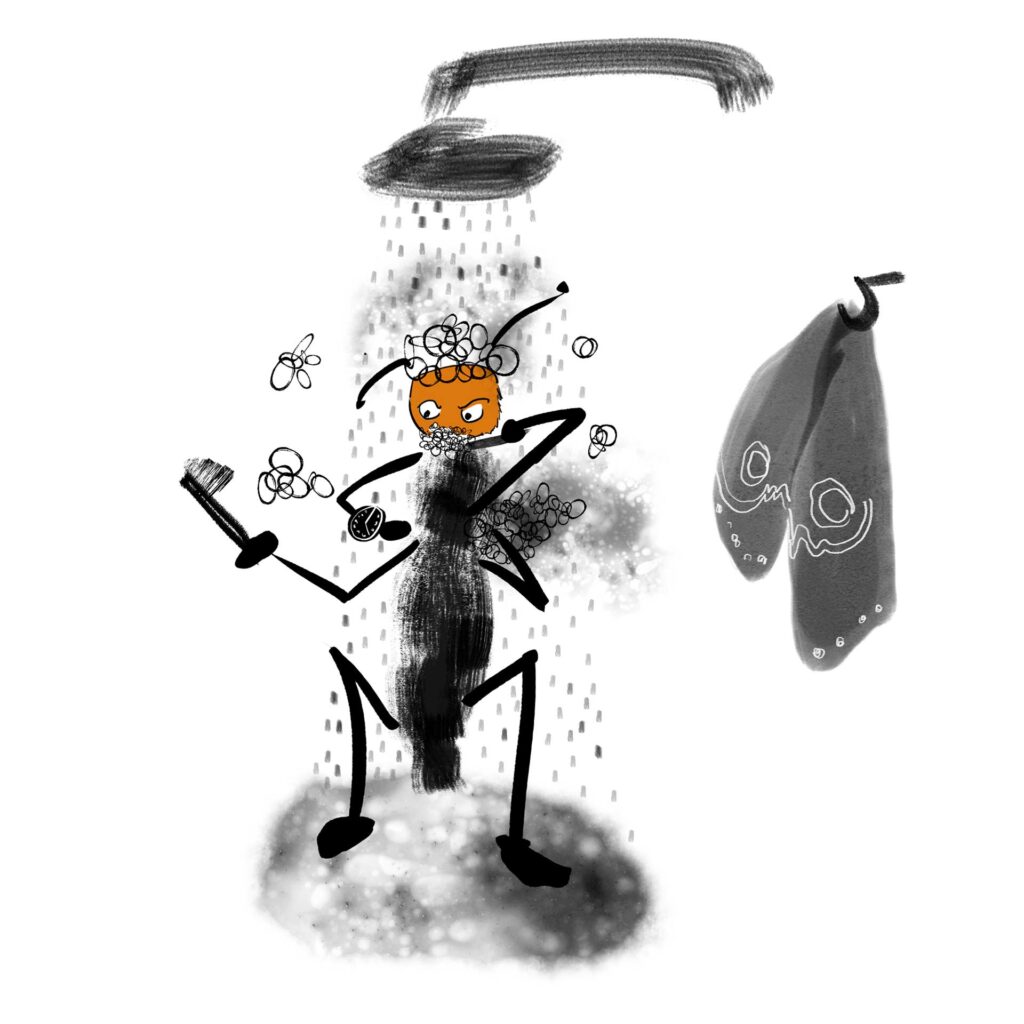
Note that most volunteering opportunities in the ACT will require you to be accompanied by someone over the age of 18.
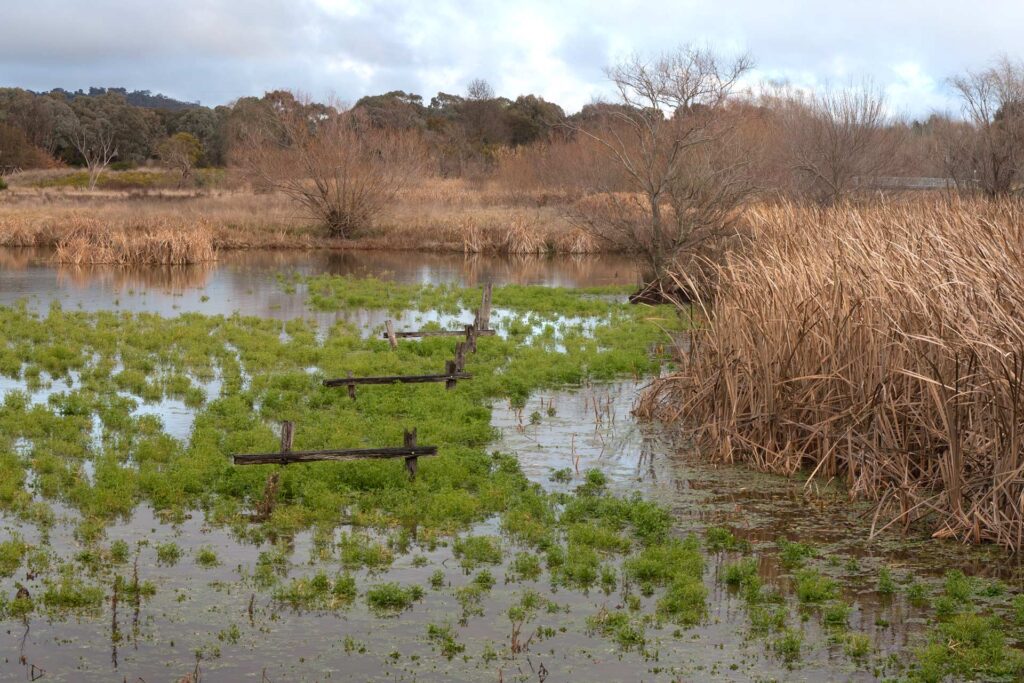
LET’S GET OUTSIDE
Visit Jerrabomberra Wetlands to discover Canberra’s wetland wildlife.
Image: Jerrabomberra wetlandsAreas of land that are covered with shallow water or are waterlogged (wet). These can be seasonal, only existing for short periods of time, or can be permanent., Photo: Raw Shorty
Activities
MATCH THE DOTS
This activity shows how the health of rivers are connected to land use. Look at the map – the different coloured dots show us the health of different areas of the river catchments. Healthy catchments mean healthy, clean rivers, lakes and wetlands.
Healthy catchmentsAn area of land on which rain falls. This land then channels the rainwater into rivers, lakes and wetlands. have plenty of nativeAnimals and plants that live in, and are originally from, an area. The area could be large, like Australia, or it could be small, like a specific national park. vegetation to support the soil and reduce the amount of pollutantsHarmful substances that can damage the environment. Water pollutants include chemicals, fertilisers, bacteria, viruses, animal or human waste, and too many nutrients. by filtering the water that runs off the land.
Data sourced from: Upper Murrumbidgee WaterWatch, based on CatchmentAn area of land on which rain falls. This land then channels the rainwater into rivers, lakes and wetlands. Health Indicator Program score for CatchmentAn area of land on which rain falls. This land then channels the rainwater into rivers, lakes and wetlands. reaches.
Think about it!
What types of land are the ‘excellent’ and ‘good’ quality catchmentsAn area of land on which rain falls. This land then channels the rainwater into rivers, lakes and wetlands. on? What type of land are the ‘fair’ (less than good) catchmentsAn area of land on which rain falls. This land then channels the rainwater into rivers, lakes and wetlands. on? Why do you think this is? How can we help to make ‘fair’ quality catchmentsAn area of land on which rain falls. This land then channels the rainwater into rivers, lakes and wetlands. better?
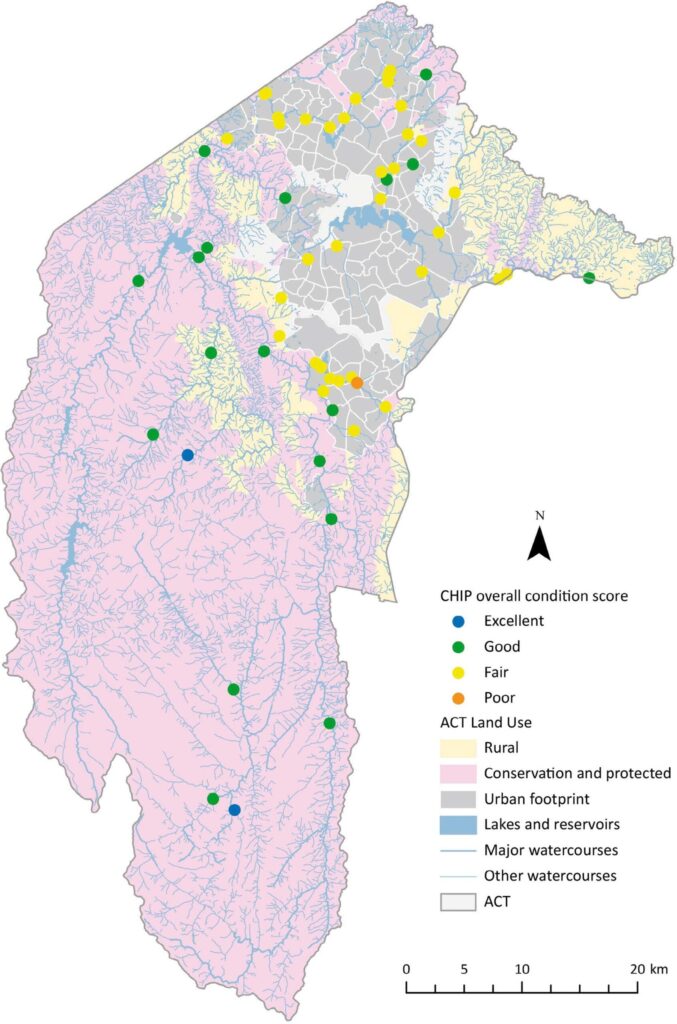
COLOURFUL FLOWERS
This activity shows us how plants help to keep our rivers, lakes and wetlands clean. Adult assistance required.
WHAT DO I NEED?
- red, blue, green food dye
- 3 vases, filled almost to the top with warm water
- 3 white flowers, cut with a long stem (white chrysanthemums, carnations and roses work well)
Watch how flowers absorb colours!
Add 30 drops of red food dye to a vase of warm water. Repeat this, adding blue dye to another vase of warm water and green dye to a third.
Cut a little bit off the bottom of each stem, cutting on an angle to increase the surface area of the stem. Then place one flower in each vase and leave for a few days.
Watch over the next few days to see what happens to the colour of the flower petals.
Making colourful flowers is fun, but it also shows us how plants absorb what is in the water. Just like the flowers absorbed the colour, they also absorb chemicals and pollutionHarmful substances that can damage the environment. Water pollutants include chemicals, fertilisers, bacteria, viruses, animal or human waste, and too many nutrients. that is in the waterways.
This is why they are so important to keep our waterways clean!
